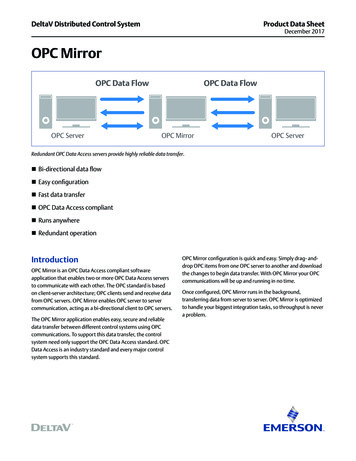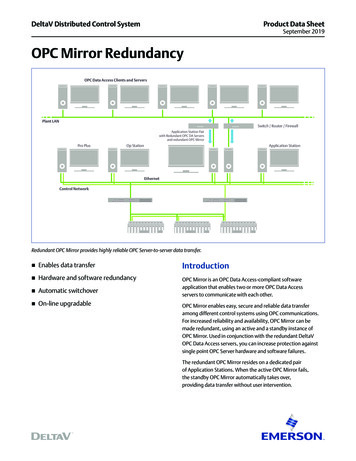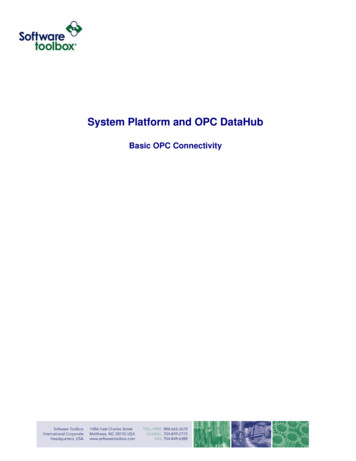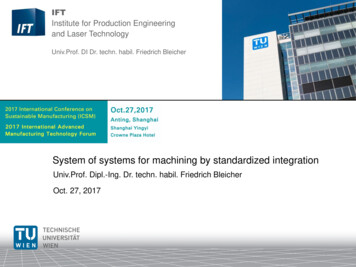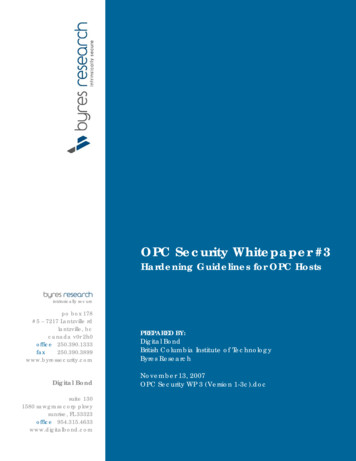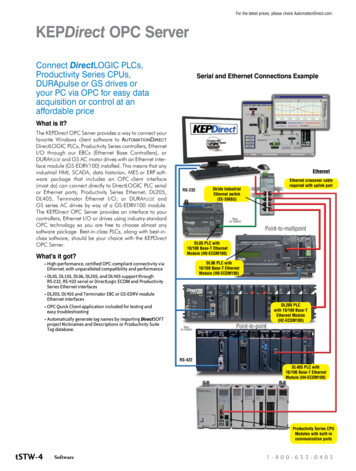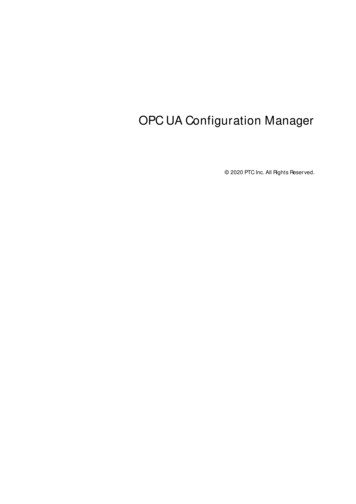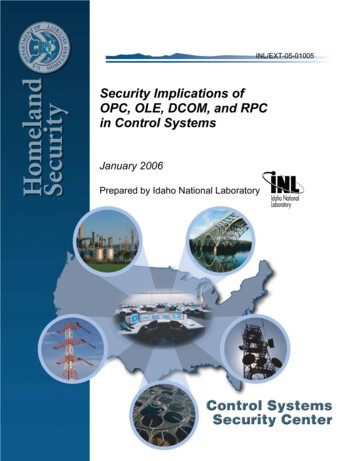
Transcription
INL/EXT-05-01005Security Implications ofOPC, OLE, DCOM, and RPCin Control SystemsJanuary 2006Prepared by Idaho National Laboratory
INL/EXT-05-0005Rev. 0Security Implications of OPC, OLE, DCOM, and RPCin Control SystemsJanuary 2006Idaho National LaboratoryIdaho Falls, Idaho 83415Prepared for theU.S. Department of Homeland SecurityUnder DOE Idaho Operations OfficeContract DE-AC07-99ID13727
Control Systems Security CenterSecurity Implications of OPC, OLE, DCOM, and RPCin Control SystemsINL/EXT-05-01005, Rev. 0January 2006
EXECUTIVE SUMMARYOPC is a collection of software programming standards and interfaces used in the processcontrol industry. It is intended to provide open connectivity and vendor equipmentinteroperability. The use of OPC technology simplifies the development of control systems thatintegrate components from multiple vendors and support multiple control protocols. OPCcompliant products are available from most control system vendors, and are widely used in theprocess control industry.OPC was originally known as OLE for Process Control; the first standards for OPC werebased on underlying services in the Microsoft Windows computing environment. Theseunderlying services (OLE [Object Linking and Embedding], DCOM [Distributed ComponentObject Model], and RPC [Remote Procedure Call]) have been the source of many severe securityvulnerabilities. It is not feasible to automatically apply vendor patches and service packs tomitigate these vulnerabilities in a control systems environment. Control systems using theoriginal OPC data access technology can thus inherit the vulnerabilities associated with theseservices.Current OPC standardization efforts are moving away from the original focus on Microsoftprotocols, with a distinct trend toward web-based protocols that are independent of any particularoperating system. However, the installed base of OPC equipment consists mainly of legacyimplementations of the OLE for Process Control protocols.i
CONTENTS1.TECHNOLOGY BACKGROUND: WHAT IS IT AND WHY DO WE CARE?.12.OPC IN THE CONTROL SYSTEMS MARKET .23.POTENTIAL FOR VULNERABILITIES IN OPC .34.3.1VULNERABILITIES IN UNDERLYING SERVICES.33.2ISSUES SPECIFIC TO OPC .4CONCLUSION.5iii
ACRONYMSAPIApplication Programming InterfaceCOMComponent Object ModelDCSDistributed Control SystemDCOMDistributed COMHMIHuman Machine InterfaceOLEObject Linking and EmbeddingOPCOLE for Process ControlPLCProgrammable Logic ControllerRPCRemote Procedure CallRTURemote Terminal UnitSCADASupervisory Control and Data Acquisitionv
SECURITY IMPLICATIONS OF OPC, OLE, DCOM, AND RPC INCONTROL SYSTEMSThe purpose of this white paper is to describe the use of OPC, OLE (Object Linking andEmbedding), DCOM (Distributed Component Object Model), and RPC (Remote Procedure Call)technologies in Supervisory Control and Data Acquisition (SCADA) and process controlsystems, and examine the implications of their use from a computer security perspective.OPC is a collection of standards and interfaces that are specific to process control,intended to provide open connectivity and vendor equipment interoperability. To quote the OPCFoundation:OPC technology can eliminate expensive custom interfaces and driverstraditionally required for moving information easily around the enterprise. Itpromotes interoperability, including amongst different computing solutions andplatforms both horizontally and vertically in the enterprise. It therefore cutscosts, speeds development and promotes increased operating efficiency.aCurrent OPC standardization efforts are moving away from the original focus on Microsoftprotocols, with a distinct trend toward web-based protocols that are independent of any particularoperating system. Most currently installed OPC equipment remains based on technologiesspecific to the Microsoft Windows environment. This paper will focus on those technologies andprotocols.1.TECHNOLOGY BACKGROUND: WHAT IS IT AND WHY DO WECARE?OPC was originally known as OLE for Process Control, as the first OPC standards werebased on Microsoft’s OLE technology. For the purposes of this paper, the history of thistechnology begins with the Component Object Model (COM). This was Microsoft’s approach todistributed object technology—implementing object-oriented interfaces across differentprocesses or different computers. COM is a client-server technology that provides a set ofinterfaces allowing clients and servers to communicate within the same computer.DCOM is COM distributed across different computers. That is, a client program object canrequest services from server program objects on other computers in a network. COM and DCOMwere originally Microsoft-specific technologies. The analogous or competing technology in theUNIX world is CORBA (Common Object Request Broker Architecture). DCOMimplementations are also available for major UNIX platforms.a. http://www.opcfoundation.org1
DCOM uses the RPC protocol to request services from COM servers on differentcomputers. RPC includes capabilities for Microsoft message queueing (MSMQ) andasynchronous communications.COM and DCOM are the underlying protocols normally used to implement OLE. OLE is aMicrosoft technology for compound documents. A compound document is something like adisplay desktop that can contain visual and information objects of all kinds: text, calendars,animations, sound, motion video, 3-D, continually updated news, controls, and so forth. Eachdesktop object is an independent program entity that can interact with a user and alsocommunicate with other objects on the desktop.b For a simple example, consider a MicrosoftWord document that contains an embedded Excel spreadsheet object. Through the use of OLE,the user can edit the Excel spreadsheet without leaving Microsoft Word: spreadsheet commandsare passed through an OLE interface to an Excel OLE automation server. If instead of a Worddocument, a programmer wanted to write a custom program that included an Excel spreadsheetembedded in the user interface, the programmer simply uses the standard OLE interfacesprovided by Excel.The utility of OLE for control system development is apparent. Conceptually, the HumanMachine Interface (HMI) display is a compound document that contains individual displayobjects for specific Programmable Logic Controllers (PLCs), Remote Terminal Units (RTUs),etc. These end devices are represented by COM server objects that know the specifics of how tocommunicate with the end device. By embedding these objects in the display and programmingto their standard Application Programming Interfaces (APIs), parameter display information caneasily be obtained, control actions can be passed from the HMI to the end devices, endpointalarms can be received, etc., yet the developer does not need to write specific interfaces to eachand every type of device (and protocol) on the system. Thus, a SCADA system HMI can easilycommunicate with a wide variety of devices from different manufacturers. Further, the use ofOLE interfaces is extremely common and well-supported in the world of Microsoft applicationdevelopers. It is easy to implement OLE automation using standardized tools such as VisualBasic and Visual C .2.OPC IN THE CONTROL SYSTEMS MARKETThe OPC Foundation (http://www.opcfoundation.org) is an industry organizationdedicated to ensuring interoperability in automation by creating and maintaining openspecifications that standardize the communication of acquired process data, alarm and eventrecords, historical data, and batch data to multi-vendor enterprise systems and betweenproduction devices. Production devices include sensors, instruments, PLCs, RTUs, DistributedControl Systems (DCS), HMIs, historians, trending subsystems, alarm subsystems, and more asused in the process industry, in manufacturing, and in acquiring and transporting oil, gas, andminerals.b. This description is taken from ,sid1 gci214126,00.html2
The original OPC specifications addressed movement of real-time data from PLCs, DCS,and other control devices to HMIs and other display clients. The OPC Foundation has sincedeveloped specifications for handling alarm and event data, access to data historian functions,server-to-server protocols, etc. There is work in progress to develop specifications for webservices, Extensible Markup Language (XML), Simple Object Access Protocol (SOAP), andothers. These latter efforts reflect the trend to web-based architectures that are less dependent ona specific operating system environment.As of October 2005, the OPC Foundation had more than 360 member companies.According to a survey article in Control Engineering magazine,c 53% of HMI systeminstallations use OPC for communications. All of the major HMI vendors include support forOPC protocols. In addition to Original Equipment Manufacturer (OEM) equipment vendors,there are third-party companies in the business of providing OPC interfaces. The largest thirdparty developer, MatrikonOPC (http://www.matrikonopc.com), has more than 500 specific OPCinterface products.3.3.1POTENTIAL FOR VULNERABILITIES IN OPCVULNERABILITIES IN UNDERLYING SERVICESAs discussed earlier, the original OPC data access standards are founded on basecapabilities provided by OLE, COM and DCOM, and RPC services. These services arecommonly used features in a Microsoft Windows enterprise environment. As such, they are alsocommon targets for security attacks. Table 1 lists some of the more severe vulnerabilitiesinvolving RPC and DCOM services.Table 1. Selected RPC and DCOM vulnerabilities.Published 28CVE-2003-0605CVE-2003-0715DescriptionDCOM information leak in Windows 2000 pre-SP3;remote attacker can obtain sensitive information.A RPC DCOM buffer overflow; remote attacker canexecute arbitrary code (exploited by the Blaster andNachi worms).A RPCSS DCOM buffer overflow; remote attacker canexecute arbitrary code.Remote DoS leading to local privilege escalation.Windows 2000 SP3 and SP4. Patched in MS03-039.A RPCSS DCOM buffer overflow; remote attacker canexecute arbitrary code.c. 3
Published VulnerabilityDescriptionCVE-2003-0807Buffer overflow in COM internet services and RPC overHTTP proxy. Patched in MS04-012.RPC DCOM denial of service. Patched in MS04-012.Problems with MS03-039.RPCSS DCOM activation; denial of service. Patched inMS04-012.The DCOM RPC interface for Microsoft Windows NT4.0, 2000, XP, and Server 2003 allows remote attackersto cause network communications via an "alter context"call that contains additional data; also known as the"Object Identity Vulnerability." High severity; remotelyexploitable. Patched in hese RPC and DCOM vulnerabilities are not specific to control system networks.However, a control system network that is using OPC is vulnerable to these threats. Controlsystem network administrators must mitigate these threats by keeping current with patches andservice packs, or applying other security measures.From the perspective of a knowledgeable attacker, knowing that OPC is being usedimplies that these underlying services are also present. The attacker could try known attackmethods against these services to gain system access.3.2ISSUES SPECIFIC TO OPCFor control systems networks, it is typically not feasible to blindly apply vendor servicepacks and patches. Asset owners must carefully test these to ensure that they do not interferewith specific capabilities that are unique to control systems, as distinct from conventional ITnetworks. Due to the difficulty of testing and deploying vendor service packs and patches, andthe time required for these activities, control systems are therefore more likely to have unpatchedvulnerabilities for which there are known exploits.One example is Windows XP Service Pack 2. If this service pack is installed with defaultsettings, OPC over DCOM will cease to work.e Using the default settings, Windows Firewallblocks traffic created by OPC callbacks (where the OPC client becomes a DCOM server, andvice versa). The recommended fix is to add all OPC client and server machines to the exceptionlist, or perhaps turn off the firewall entirely (if appropriate within the network). The firewallmust allow incoming Transmission Control Protocol (TCP) port 135, and some COM securityd. /MS04-012.mspxe. %20and%20Security.pdf4
settings must be modified from their defaults. Note that a particular installation might haveassigned services to port numbers other than the typical defaults; these port numbers might alsobe blocked by the default firewall settings in Service Pack 2.Since OPC client applications are inherently distributed applications, they also involvesecurity and authentication mechanisms. They rely on standard Windows RPC mechanisms forsecurity controls. Access Control Lists are used for OLE components in the same manner as forfiles and directories. As of 1998, “ most OPC client vendors implemented browsing forremote OPC Servers by using the Registry API’s that support access to a remote machine’sregistry.”f Allowing remote registry access gives potential attackers an additional means of entry,particularly if the access control lists are not configured for maximum security. There are effortsunderway to resolve this security issue by developing alternate browsing mechanisms.Similarly, opcenum.exe, a commonly used tool for browsing available OPC servers on thenetwork, requires that anonymous login be enabled. Some other OPC clients and servers alsohave this requirement. The use of anonymous login accounts presents an obvious securityconcern.4.CONCLUSIONControl systems using OPC technology inherit the vulnerabilities associated with theunderlying RPC and DCOM services in Microsoft Windows environments. These services havebeen a source of many severe vulnerabilities; exploits against unpatched systems are widelyavailable. The system configuration required for OPC usage precludes the automatic applicationof security patches and service packs for the operating system. Asset owners should remainaware of the vulnerabilities presented by unpatched systems using these services, and ensure thatother appropriate security controls are in place when conventional patches cannot be applied.f. %20and%20Security.pdf5
Using the default settings, Windows Firewall blocks traffic created by OPC callbacks (where the OPC client becomes a DCOM server, and vice versa). The recommended fix is to add all OPC client and server machines to the exception list, or perhaps turn off the firewall entirely (if appropriate within the network). The firewall
